Analyzing Hull and Propeller Management for Optimal Fuel Usage
VerifiedAdded on 2023/04/21
|12
|2848
|333
Report
AI Summary
This report discusses the critical role of hull and propeller management in achieving fuel efficiency within the maritime industry, highlighting the challenges and solutions related to hull fouling and propeller degradation. It emphasizes the importance of adhering to standards like ISO-19030 for monitoring hull and propeller performance, reducing fuel consumption, and minimizing carbon emissions. The report explores various factors influencing hull performance, including anti-fouling preparations, water cleaning techniques, and the impact of biofouling on vessel efficiency and biosecurity. It also addresses the use of antifouling coatings, in-water cleaning methods, and the need for responsible waste disposal to protect the marine environment. Ultimately, the report underscores the significance of evaluating vessel performance and implementing innovative hull coating technologies to optimize fuel consumption, reduce operational costs, and promote environmental sustainability in the shipping industry.

1
HULL AND PROPELLER MANAGEMENT
Student’s Name:
Course Name:
Date of Submission:
HULL AND PROPELLER MANAGEMENT
Student’s Name:
Course Name:
Date of Submission:
Paraphrase This Document
Need a fresh take? Get an instant paraphrase of this document with our AI Paraphraser

2
HULL AND PROPELLER MANAGEMENT
Fuel efficiency has remained a fundamental concern for businesses, but tracking construction
and propeller degradation is a situation that remains unresolved. Experts indicate that due to the
consequence of hull fouling, the marine industry would sail with thirty per cent added resistance
thus demand for fuel consumption increase. Undertaking hull and propeller improvement on a
daily basis is already recognised by business owners as vital. However, the biggest hurdle
remains as to when and how the process should be carried out as it have not consistently been
conveyed. To meet the strict gas emission legislation for the marine industry in actualising green
shipping, designers and ship owners have faced significant hurdles in obtaining good operational
shipping behaviour during sailing. The by-product of this increased fuel consumption is the
emission of more carbon dioxide to the environment hence global warming and poses a danger to
aquatic life1.
The consequences associated with the condition of the ship’s structure and the propeller on the
bunker demand by the sailing vessel is significant. The current business standards ISO-19030
developed by shipping, paint and propeller manufacturers; scientists and information analysts
provide a detailed method on how to measure hull and propeller performance2. Ship owners have
1 Bakalar, Goran, and Vinko Tomas. "Possibility of using flow cytometry in the treated ballast
water quality detection." Pomorski zbornik 51, no. 1 (2016): 43-55. [Online]. Available at:
https://hrcak.srce.hr/index.php?id_clanak_jezik=226168&show=clanak
2 Lindholdt, Asger, Kim Dam-Johansen, Diego Meseguer Yebra, Søren Kiil, Claus Erik Weinell,
and Stefan Møller Olsen. "Fuel efficiency and fouling control coatings in maritime transport."
(2015). [Online]. Available at: http://orbit.dtu.dk/portal/en/publications/id(6cf08556-0c9e-43b8-
HULL AND PROPELLER MANAGEMENT
Fuel efficiency has remained a fundamental concern for businesses, but tracking construction
and propeller degradation is a situation that remains unresolved. Experts indicate that due to the
consequence of hull fouling, the marine industry would sail with thirty per cent added resistance
thus demand for fuel consumption increase. Undertaking hull and propeller improvement on a
daily basis is already recognised by business owners as vital. However, the biggest hurdle
remains as to when and how the process should be carried out as it have not consistently been
conveyed. To meet the strict gas emission legislation for the marine industry in actualising green
shipping, designers and ship owners have faced significant hurdles in obtaining good operational
shipping behaviour during sailing. The by-product of this increased fuel consumption is the
emission of more carbon dioxide to the environment hence global warming and poses a danger to
aquatic life1.
The consequences associated with the condition of the ship’s structure and the propeller on the
bunker demand by the sailing vessel is significant. The current business standards ISO-19030
developed by shipping, paint and propeller manufacturers; scientists and information analysts
provide a detailed method on how to measure hull and propeller performance2. Ship owners have
1 Bakalar, Goran, and Vinko Tomas. "Possibility of using flow cytometry in the treated ballast
water quality detection." Pomorski zbornik 51, no. 1 (2016): 43-55. [Online]. Available at:
https://hrcak.srce.hr/index.php?id_clanak_jezik=226168&show=clanak
2 Lindholdt, Asger, Kim Dam-Johansen, Diego Meseguer Yebra, Søren Kiil, Claus Erik Weinell,
and Stefan Møller Olsen. "Fuel efficiency and fouling control coatings in maritime transport."
(2015). [Online]. Available at: http://orbit.dtu.dk/portal/en/publications/id(6cf08556-0c9e-43b8-
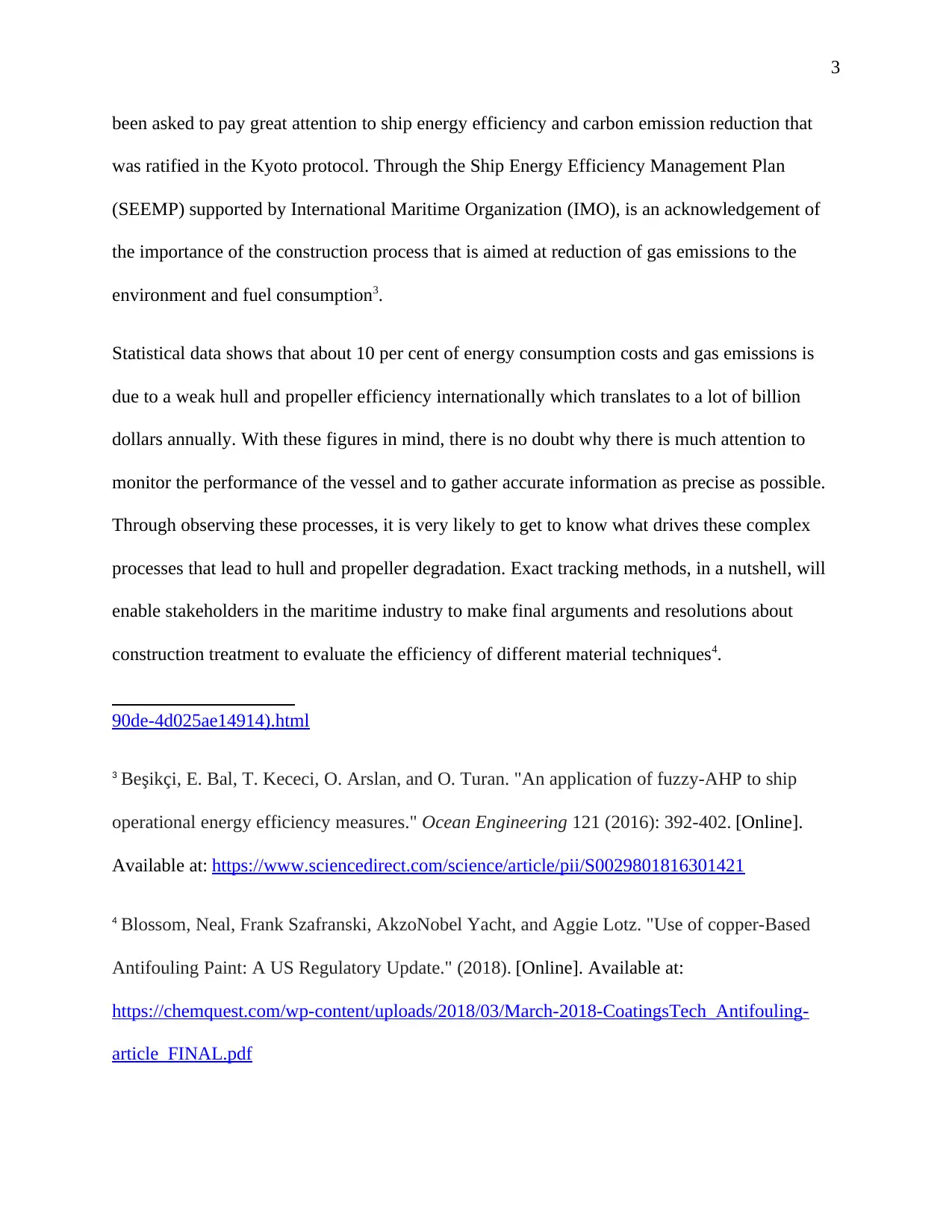
3
been asked to pay great attention to ship energy efficiency and carbon emission reduction that
was ratified in the Kyoto protocol. Through the Ship Energy Efficiency Management Plan
(SEEMP) supported by International Maritime Organization (IMO), is an acknowledgement of
the importance of the construction process that is aimed at reduction of gas emissions to the
environment and fuel consumption3.
Statistical data shows that about 10 per cent of energy consumption costs and gas emissions is
due to a weak hull and propeller efficiency internationally which translates to a lot of billion
dollars annually. With these figures in mind, there is no doubt why there is much attention to
monitor the performance of the vessel and to gather accurate information as precise as possible.
Through observing these processes, it is very likely to get to know what drives these complex
processes that lead to hull and propeller degradation. Exact tracking methods, in a nutshell, will
enable stakeholders in the maritime industry to make final arguments and resolutions about
construction treatment to evaluate the efficiency of different material techniques4.
90de-4d025ae14914).html
3 Beşikçi, E. Bal, T. Kececi, O. Arslan, and O. Turan. "An application of fuzzy-AHP to ship
operational energy efficiency measures." Ocean Engineering 121 (2016): 392-402. [Online].
Available at: https://www.sciencedirect.com/science/article/pii/S0029801816301421
4 Blossom, Neal, Frank Szafranski, AkzoNobel Yacht, and Aggie Lotz. "Use of copper-Based
Antifouling Paint: A US Regulatory Update." (2018). [Online]. Available at:
https://chemquest.com/wp-content/uploads/2018/03/March-2018-CoatingsTech_Antifouling-
article_FINAL.pdf
been asked to pay great attention to ship energy efficiency and carbon emission reduction that
was ratified in the Kyoto protocol. Through the Ship Energy Efficiency Management Plan
(SEEMP) supported by International Maritime Organization (IMO), is an acknowledgement of
the importance of the construction process that is aimed at reduction of gas emissions to the
environment and fuel consumption3.
Statistical data shows that about 10 per cent of energy consumption costs and gas emissions is
due to a weak hull and propeller efficiency internationally which translates to a lot of billion
dollars annually. With these figures in mind, there is no doubt why there is much attention to
monitor the performance of the vessel and to gather accurate information as precise as possible.
Through observing these processes, it is very likely to get to know what drives these complex
processes that lead to hull and propeller degradation. Exact tracking methods, in a nutshell, will
enable stakeholders in the maritime industry to make final arguments and resolutions about
construction treatment to evaluate the efficiency of different material techniques4.
90de-4d025ae14914).html
3 Beşikçi, E. Bal, T. Kececi, O. Arslan, and O. Turan. "An application of fuzzy-AHP to ship
operational energy efficiency measures." Ocean Engineering 121 (2016): 392-402. [Online].
Available at: https://www.sciencedirect.com/science/article/pii/S0029801816301421
4 Blossom, Neal, Frank Szafranski, AkzoNobel Yacht, and Aggie Lotz. "Use of copper-Based
Antifouling Paint: A US Regulatory Update." (2018). [Online]. Available at:
https://chemquest.com/wp-content/uploads/2018/03/March-2018-CoatingsTech_Antifouling-
article_FINAL.pdf
⊘ This is a preview!⊘
Do you want full access?
Subscribe today to unlock all pages.

Trusted by 1+ million students worldwide
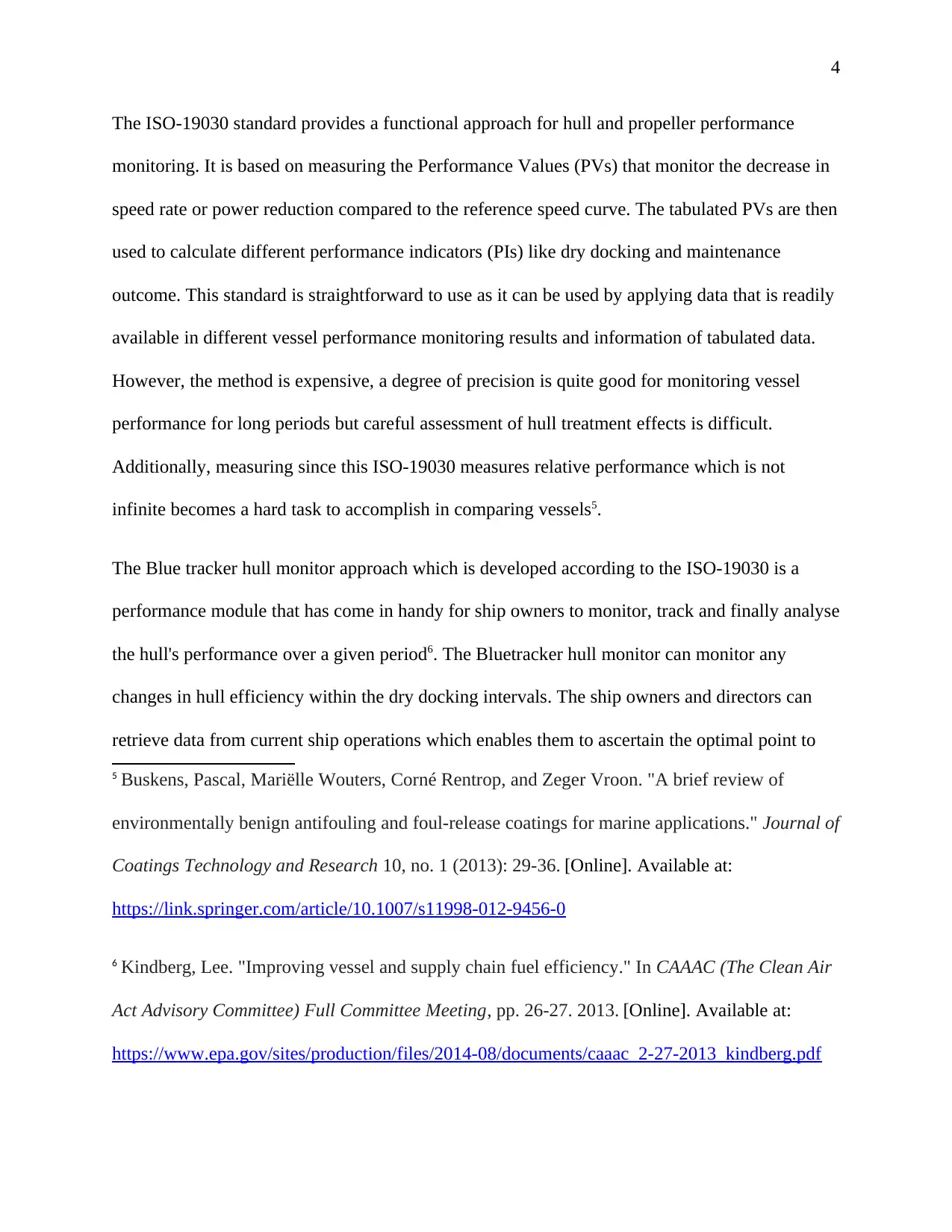
4
The ISO-19030 standard provides a functional approach for hull and propeller performance
monitoring. It is based on measuring the Performance Values (PVs) that monitor the decrease in
speed rate or power reduction compared to the reference speed curve. The tabulated PVs are then
used to calculate different performance indicators (PIs) like dry docking and maintenance
outcome. This standard is straightforward to use as it can be used by applying data that is readily
available in different vessel performance monitoring results and information of tabulated data.
However, the method is expensive, a degree of precision is quite good for monitoring vessel
performance for long periods but careful assessment of hull treatment effects is difficult.
Additionally, measuring since this ISO-19030 measures relative performance which is not
infinite becomes a hard task to accomplish in comparing vessels5.
The Blue tracker hull monitor approach which is developed according to the ISO-19030 is a
performance module that has come in handy for ship owners to monitor, track and finally analyse
the hull's performance over a given period6. The Bluetracker hull monitor can monitor any
changes in hull efficiency within the dry docking intervals. The ship owners and directors can
retrieve data from current ship operations which enables them to ascertain the optimal point to
5 Buskens, Pascal, Mariëlle Wouters, Corné Rentrop, and Zeger Vroon. "A brief review of
environmentally benign antifouling and foul-release coatings for marine applications." Journal of
Coatings Technology and Research 10, no. 1 (2013): 29-36. [Online]. Available at:
https://link.springer.com/article/10.1007/s11998-012-9456-0
6 Kindberg, Lee. "Improving vessel and supply chain fuel efficiency." In CAAAC (The Clean Air
Act Advisory Committee) Full Committee Meeting, pp. 26-27. 2013. [Online]. Available at:
https://www.epa.gov/sites/production/files/2014-08/documents/caaac_2-27-2013_kindberg.pdf
The ISO-19030 standard provides a functional approach for hull and propeller performance
monitoring. It is based on measuring the Performance Values (PVs) that monitor the decrease in
speed rate or power reduction compared to the reference speed curve. The tabulated PVs are then
used to calculate different performance indicators (PIs) like dry docking and maintenance
outcome. This standard is straightforward to use as it can be used by applying data that is readily
available in different vessel performance monitoring results and information of tabulated data.
However, the method is expensive, a degree of precision is quite good for monitoring vessel
performance for long periods but careful assessment of hull treatment effects is difficult.
Additionally, measuring since this ISO-19030 measures relative performance which is not
infinite becomes a hard task to accomplish in comparing vessels5.
The Blue tracker hull monitor approach which is developed according to the ISO-19030 is a
performance module that has come in handy for ship owners to monitor, track and finally analyse
the hull's performance over a given period6. The Bluetracker hull monitor can monitor any
changes in hull efficiency within the dry docking intervals. The ship owners and directors can
retrieve data from current ship operations which enables them to ascertain the optimal point to
5 Buskens, Pascal, Mariëlle Wouters, Corné Rentrop, and Zeger Vroon. "A brief review of
environmentally benign antifouling and foul-release coatings for marine applications." Journal of
Coatings Technology and Research 10, no. 1 (2013): 29-36. [Online]. Available at:
https://link.springer.com/article/10.1007/s11998-012-9456-0
6 Kindberg, Lee. "Improving vessel and supply chain fuel efficiency." In CAAAC (The Clean Air
Act Advisory Committee) Full Committee Meeting, pp. 26-27. 2013. [Online]. Available at:
https://www.epa.gov/sites/production/files/2014-08/documents/caaac_2-27-2013_kindberg.pdf
Paraphrase This Document
Need a fresh take? Get an instant paraphrase of this document with our AI Paraphraser
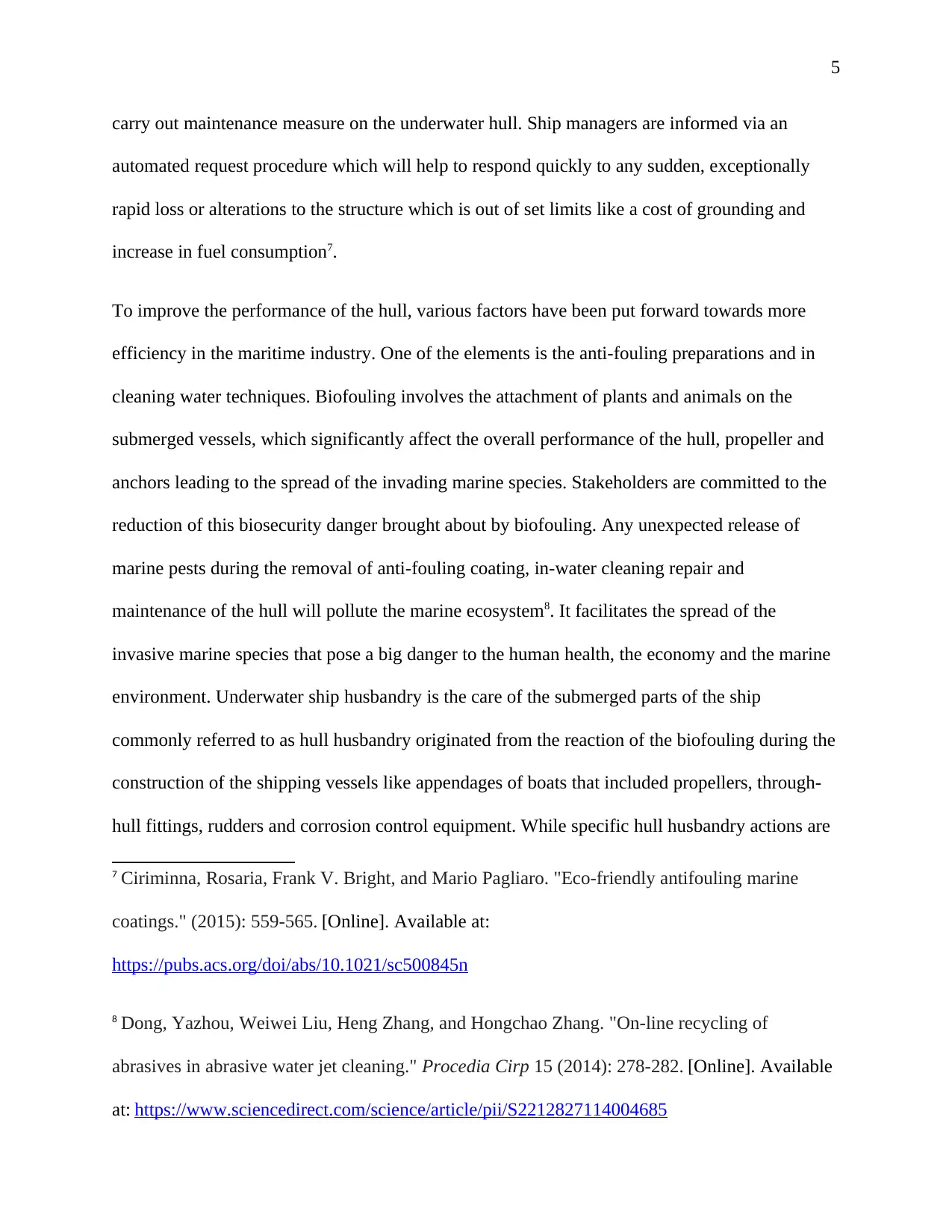
5
carry out maintenance measure on the underwater hull. Ship managers are informed via an
automated request procedure which will help to respond quickly to any sudden, exceptionally
rapid loss or alterations to the structure which is out of set limits like a cost of grounding and
increase in fuel consumption7.
To improve the performance of the hull, various factors have been put forward towards more
efficiency in the maritime industry. One of the elements is the anti-fouling preparations and in
cleaning water techniques. Biofouling involves the attachment of plants and animals on the
submerged vessels, which significantly affect the overall performance of the hull, propeller and
anchors leading to the spread of the invading marine species. Stakeholders are committed to the
reduction of this biosecurity danger brought about by biofouling. Any unexpected release of
marine pests during the removal of anti-fouling coating, in-water cleaning repair and
maintenance of the hull will pollute the marine ecosystem8. It facilitates the spread of the
invasive marine species that pose a big danger to the human health, the economy and the marine
environment. Underwater ship husbandry is the care of the submerged parts of the ship
commonly referred to as hull husbandry originated from the reaction of the biofouling during the
construction of the shipping vessels like appendages of boats that included propellers, through-
hull fittings, rudders and corrosion control equipment. While specific hull husbandry actions are
7 Ciriminna, Rosaria, Frank V. Bright, and Mario Pagliaro. "Eco-friendly antifouling marine
coatings." (2015): 559-565. [Online]. Available at:
https://pubs.acs.org/doi/abs/10.1021/sc500845n
8 Dong, Yazhou, Weiwei Liu, Heng Zhang, and Hongchao Zhang. "On-line recycling of
abrasives in abrasive water jet cleaning." Procedia Cirp 15 (2014): 278-282. [Online]. Available
at: https://www.sciencedirect.com/science/article/pii/S2212827114004685
carry out maintenance measure on the underwater hull. Ship managers are informed via an
automated request procedure which will help to respond quickly to any sudden, exceptionally
rapid loss or alterations to the structure which is out of set limits like a cost of grounding and
increase in fuel consumption7.
To improve the performance of the hull, various factors have been put forward towards more
efficiency in the maritime industry. One of the elements is the anti-fouling preparations and in
cleaning water techniques. Biofouling involves the attachment of plants and animals on the
submerged vessels, which significantly affect the overall performance of the hull, propeller and
anchors leading to the spread of the invading marine species. Stakeholders are committed to the
reduction of this biosecurity danger brought about by biofouling. Any unexpected release of
marine pests during the removal of anti-fouling coating, in-water cleaning repair and
maintenance of the hull will pollute the marine ecosystem8. It facilitates the spread of the
invasive marine species that pose a big danger to the human health, the economy and the marine
environment. Underwater ship husbandry is the care of the submerged parts of the ship
commonly referred to as hull husbandry originated from the reaction of the biofouling during the
construction of the shipping vessels like appendages of boats that included propellers, through-
hull fittings, rudders and corrosion control equipment. While specific hull husbandry actions are
7 Ciriminna, Rosaria, Frank V. Bright, and Mario Pagliaro. "Eco-friendly antifouling marine
coatings." (2015): 559-565. [Online]. Available at:
https://pubs.acs.org/doi/abs/10.1021/sc500845n
8 Dong, Yazhou, Weiwei Liu, Heng Zhang, and Hongchao Zhang. "On-line recycling of
abrasives in abrasive water jet cleaning." Procedia Cirp 15 (2014): 278-282. [Online]. Available
at: https://www.sciencedirect.com/science/article/pii/S2212827114004685
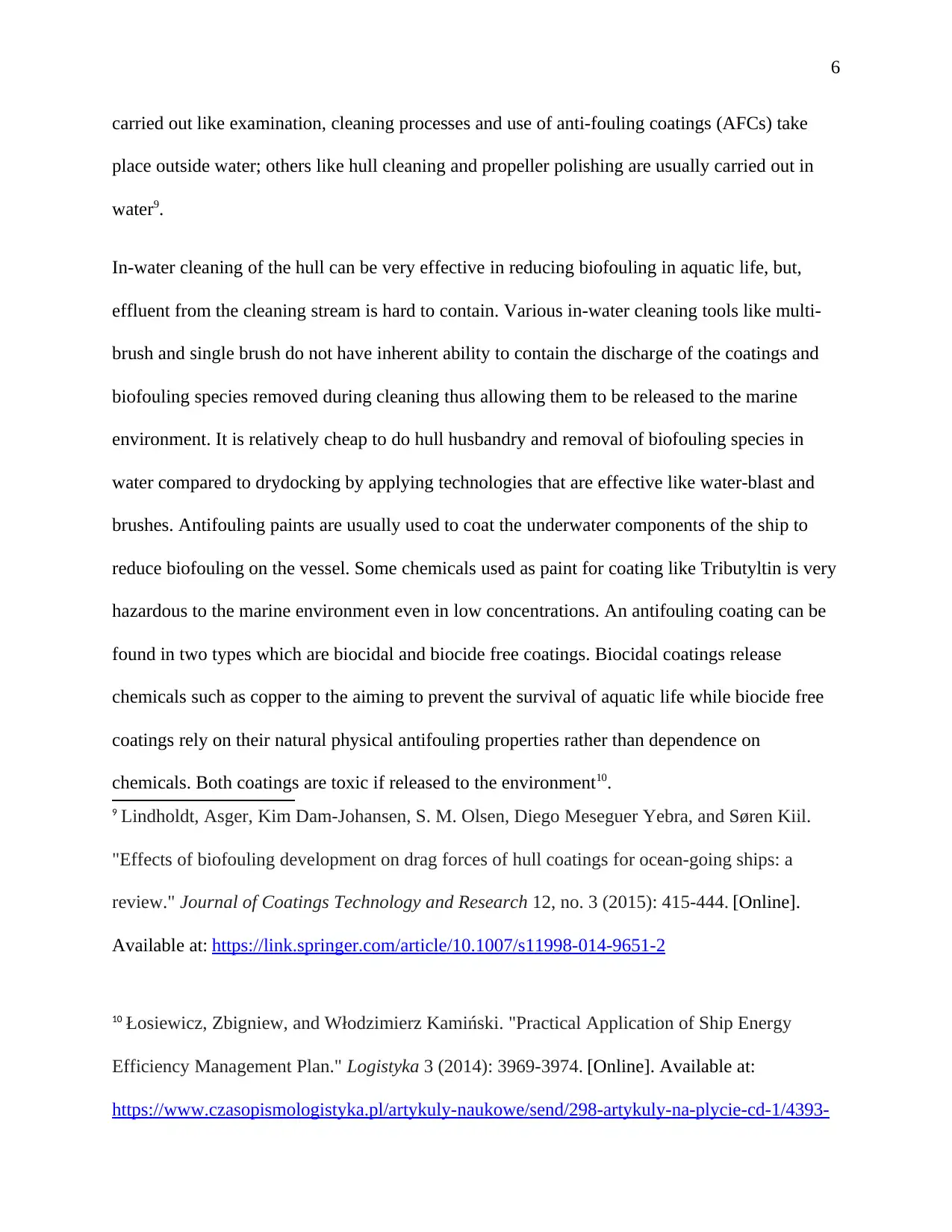
6
carried out like examination, cleaning processes and use of anti-fouling coatings (AFCs) take
place outside water; others like hull cleaning and propeller polishing are usually carried out in
water9.
In-water cleaning of the hull can be very effective in reducing biofouling in aquatic life, but,
effluent from the cleaning stream is hard to contain. Various in-water cleaning tools like multi-
brush and single brush do not have inherent ability to contain the discharge of the coatings and
biofouling species removed during cleaning thus allowing them to be released to the marine
environment. It is relatively cheap to do hull husbandry and removal of biofouling species in
water compared to drydocking by applying technologies that are effective like water-blast and
brushes. Antifouling paints are usually used to coat the underwater components of the ship to
reduce biofouling on the vessel. Some chemicals used as paint for coating like Tributyltin is very
hazardous to the marine environment even in low concentrations. An antifouling coating can be
found in two types which are biocidal and biocide free coatings. Biocidal coatings release
chemicals such as copper to the aiming to prevent the survival of aquatic life while biocide free
coatings rely on their natural physical antifouling properties rather than dependence on
chemicals. Both coatings are toxic if released to the environment10.
9 Lindholdt, Asger, Kim Dam-Johansen, S. M. Olsen, Diego Meseguer Yebra, and Søren Kiil.
"Effects of biofouling development on drag forces of hull coatings for ocean-going ships: a
review." Journal of Coatings Technology and Research 12, no. 3 (2015): 415-444. [Online].
Available at: https://link.springer.com/article/10.1007/s11998-014-9651-2
10 Łosiewicz, Zbigniew, and Włodzimierz Kamiński. "Practical Application of Ship Energy
Efficiency Management Plan." Logistyka 3 (2014): 3969-3974. [Online]. Available at:
https://www.czasopismologistyka.pl/artykuly-naukowe/send/298-artykuly-na-plycie-cd-1/4393-
carried out like examination, cleaning processes and use of anti-fouling coatings (AFCs) take
place outside water; others like hull cleaning and propeller polishing are usually carried out in
water9.
In-water cleaning of the hull can be very effective in reducing biofouling in aquatic life, but,
effluent from the cleaning stream is hard to contain. Various in-water cleaning tools like multi-
brush and single brush do not have inherent ability to contain the discharge of the coatings and
biofouling species removed during cleaning thus allowing them to be released to the marine
environment. It is relatively cheap to do hull husbandry and removal of biofouling species in
water compared to drydocking by applying technologies that are effective like water-blast and
brushes. Antifouling paints are usually used to coat the underwater components of the ship to
reduce biofouling on the vessel. Some chemicals used as paint for coating like Tributyltin is very
hazardous to the marine environment even in low concentrations. An antifouling coating can be
found in two types which are biocidal and biocide free coatings. Biocidal coatings release
chemicals such as copper to the aiming to prevent the survival of aquatic life while biocide free
coatings rely on their natural physical antifouling properties rather than dependence on
chemicals. Both coatings are toxic if released to the environment10.
9 Lindholdt, Asger, Kim Dam-Johansen, S. M. Olsen, Diego Meseguer Yebra, and Søren Kiil.
"Effects of biofouling development on drag forces of hull coatings for ocean-going ships: a
review." Journal of Coatings Technology and Research 12, no. 3 (2015): 415-444. [Online].
Available at: https://link.springer.com/article/10.1007/s11998-014-9651-2
10 Łosiewicz, Zbigniew, and Włodzimierz Kamiński. "Practical Application of Ship Energy
Efficiency Management Plan." Logistyka 3 (2014): 3969-3974. [Online]. Available at:
https://www.czasopismologistyka.pl/artykuly-naukowe/send/298-artykuly-na-plycie-cd-1/4393-
⊘ This is a preview!⊘
Do you want full access?
Subscribe today to unlock all pages.

Trusted by 1+ million students worldwide
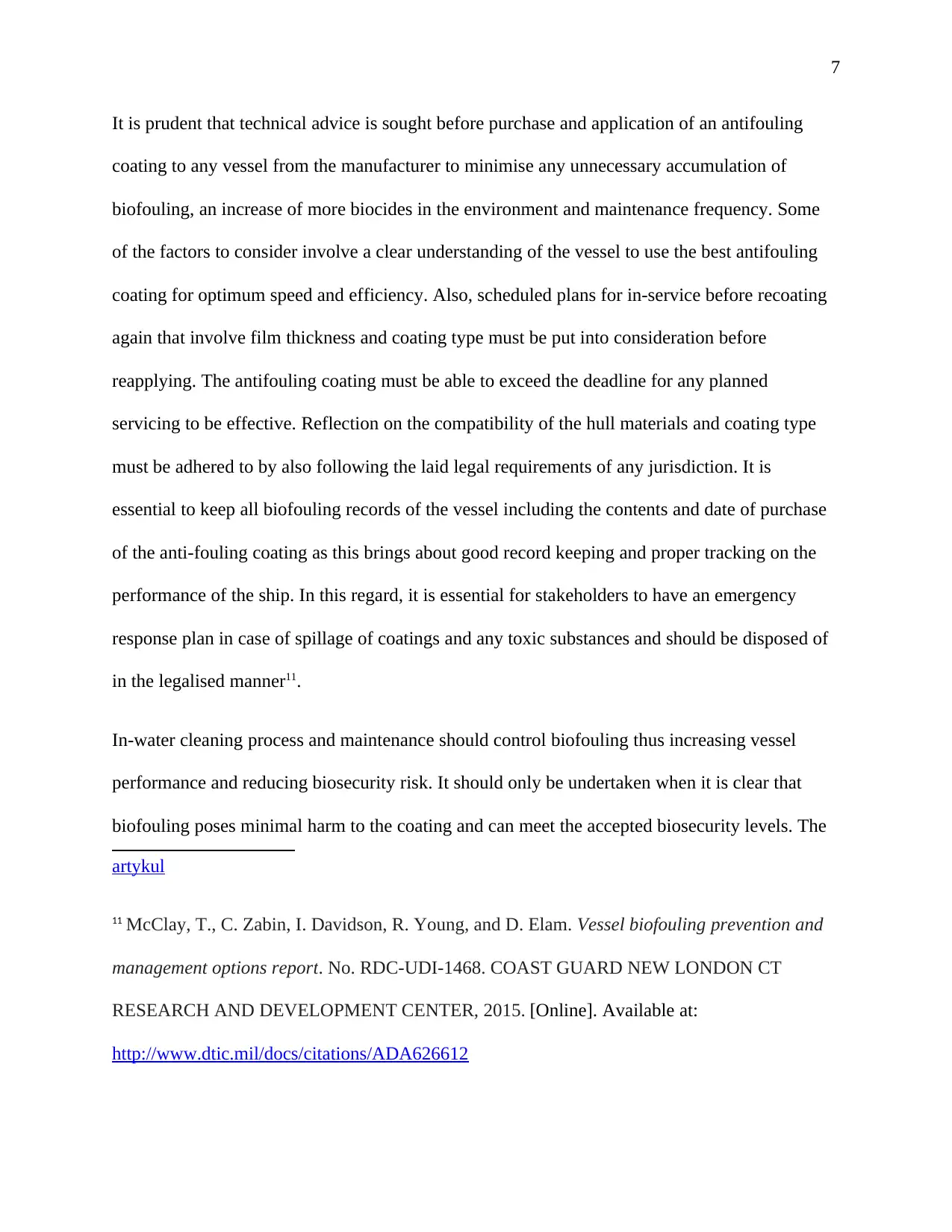
7
It is prudent that technical advice is sought before purchase and application of an antifouling
coating to any vessel from the manufacturer to minimise any unnecessary accumulation of
biofouling, an increase of more biocides in the environment and maintenance frequency. Some
of the factors to consider involve a clear understanding of the vessel to use the best antifouling
coating for optimum speed and efficiency. Also, scheduled plans for in-service before recoating
again that involve film thickness and coating type must be put into consideration before
reapplying. The antifouling coating must be able to exceed the deadline for any planned
servicing to be effective. Reflection on the compatibility of the hull materials and coating type
must be adhered to by also following the laid legal requirements of any jurisdiction. It is
essential to keep all biofouling records of the vessel including the contents and date of purchase
of the anti-fouling coating as this brings about good record keeping and proper tracking on the
performance of the ship. In this regard, it is essential for stakeholders to have an emergency
response plan in case of spillage of coatings and any toxic substances and should be disposed of
in the legalised manner11.
In-water cleaning process and maintenance should control biofouling thus increasing vessel
performance and reducing biosecurity risk. It should only be undertaken when it is clear that
biofouling poses minimal harm to the coating and can meet the accepted biosecurity levels. The
artykul
11 McClay, T., C. Zabin, I. Davidson, R. Young, and D. Elam. Vessel biofouling prevention and
management options report. No. RDC-UDI-1468. COAST GUARD NEW LONDON CT
RESEARCH AND DEVELOPMENT CENTER, 2015. [Online]. Available at:
http://www.dtic.mil/docs/citations/ADA626612
It is prudent that technical advice is sought before purchase and application of an antifouling
coating to any vessel from the manufacturer to minimise any unnecessary accumulation of
biofouling, an increase of more biocides in the environment and maintenance frequency. Some
of the factors to consider involve a clear understanding of the vessel to use the best antifouling
coating for optimum speed and efficiency. Also, scheduled plans for in-service before recoating
again that involve film thickness and coating type must be put into consideration before
reapplying. The antifouling coating must be able to exceed the deadline for any planned
servicing to be effective. Reflection on the compatibility of the hull materials and coating type
must be adhered to by also following the laid legal requirements of any jurisdiction. It is
essential to keep all biofouling records of the vessel including the contents and date of purchase
of the anti-fouling coating as this brings about good record keeping and proper tracking on the
performance of the ship. In this regard, it is essential for stakeholders to have an emergency
response plan in case of spillage of coatings and any toxic substances and should be disposed of
in the legalised manner11.
In-water cleaning process and maintenance should control biofouling thus increasing vessel
performance and reducing biosecurity risk. It should only be undertaken when it is clear that
biofouling poses minimal harm to the coating and can meet the accepted biosecurity levels. The
artykul
11 McClay, T., C. Zabin, I. Davidson, R. Young, and D. Elam. Vessel biofouling prevention and
management options report. No. RDC-UDI-1468. COAST GUARD NEW LONDON CT
RESEARCH AND DEVELOPMENT CENTER, 2015. [Online]. Available at:
http://www.dtic.mil/docs/citations/ADA626612
Paraphrase This Document
Need a fresh take? Get an instant paraphrase of this document with our AI Paraphraser
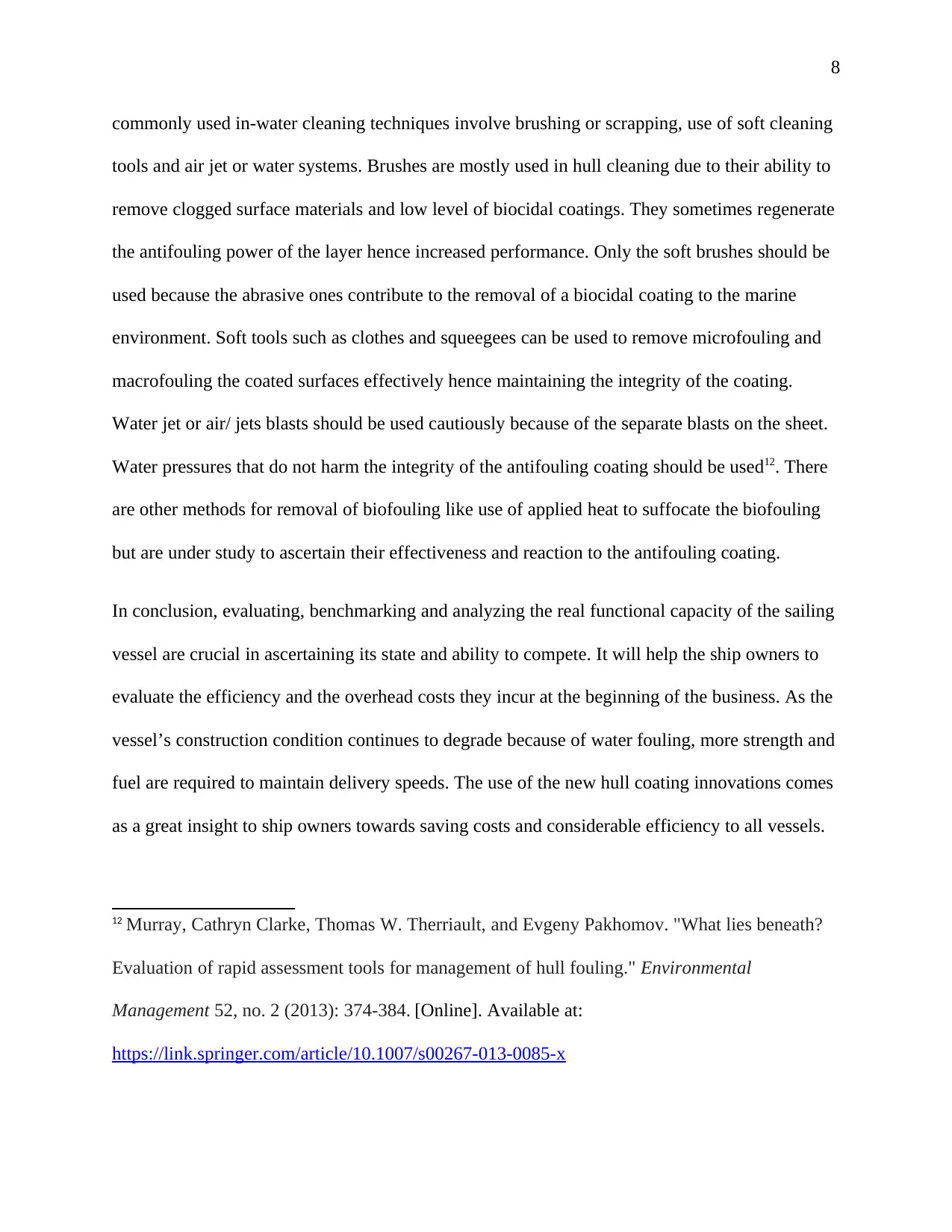
8
commonly used in-water cleaning techniques involve brushing or scrapping, use of soft cleaning
tools and air jet or water systems. Brushes are mostly used in hull cleaning due to their ability to
remove clogged surface materials and low level of biocidal coatings. They sometimes regenerate
the antifouling power of the layer hence increased performance. Only the soft brushes should be
used because the abrasive ones contribute to the removal of a biocidal coating to the marine
environment. Soft tools such as clothes and squeegees can be used to remove microfouling and
macrofouling the coated surfaces effectively hence maintaining the integrity of the coating.
Water jet or air/ jets blasts should be used cautiously because of the separate blasts on the sheet.
Water pressures that do not harm the integrity of the antifouling coating should be used12. There
are other methods for removal of biofouling like use of applied heat to suffocate the biofouling
but are under study to ascertain their effectiveness and reaction to the antifouling coating.
In conclusion, evaluating, benchmarking and analyzing the real functional capacity of the sailing
vessel are crucial in ascertaining its state and ability to compete. It will help the ship owners to
evaluate the efficiency and the overhead costs they incur at the beginning of the business. As the
vessel’s construction condition continues to degrade because of water fouling, more strength and
fuel are required to maintain delivery speeds. The use of the new hull coating innovations comes
as a great insight to ship owners towards saving costs and considerable efficiency to all vessels.
12 Murray, Cathryn Clarke, Thomas W. Therriault, and Evgeny Pakhomov. "What lies beneath?
Evaluation of rapid assessment tools for management of hull fouling." Environmental
Management 52, no. 2 (2013): 374-384. [Online]. Available at:
https://link.springer.com/article/10.1007/s00267-013-0085-x
commonly used in-water cleaning techniques involve brushing or scrapping, use of soft cleaning
tools and air jet or water systems. Brushes are mostly used in hull cleaning due to their ability to
remove clogged surface materials and low level of biocidal coatings. They sometimes regenerate
the antifouling power of the layer hence increased performance. Only the soft brushes should be
used because the abrasive ones contribute to the removal of a biocidal coating to the marine
environment. Soft tools such as clothes and squeegees can be used to remove microfouling and
macrofouling the coated surfaces effectively hence maintaining the integrity of the coating.
Water jet or air/ jets blasts should be used cautiously because of the separate blasts on the sheet.
Water pressures that do not harm the integrity of the antifouling coating should be used12. There
are other methods for removal of biofouling like use of applied heat to suffocate the biofouling
but are under study to ascertain their effectiveness and reaction to the antifouling coating.
In conclusion, evaluating, benchmarking and analyzing the real functional capacity of the sailing
vessel are crucial in ascertaining its state and ability to compete. It will help the ship owners to
evaluate the efficiency and the overhead costs they incur at the beginning of the business. As the
vessel’s construction condition continues to degrade because of water fouling, more strength and
fuel are required to maintain delivery speeds. The use of the new hull coating innovations comes
as a great insight to ship owners towards saving costs and considerable efficiency to all vessels.
12 Murray, Cathryn Clarke, Thomas W. Therriault, and Evgeny Pakhomov. "What lies beneath?
Evaluation of rapid assessment tools for management of hull fouling." Environmental
Management 52, no. 2 (2013): 374-384. [Online]. Available at:
https://link.springer.com/article/10.1007/s00267-013-0085-x

9
Bibliography
Bakalar, Goran, and Vinko Tomas. "Possibility of using flow cytometry in the treated ballast
water quality detection." Pomorski zbornik 51, no. 1 (2016): 43-55. [Online]. Available
at: https://hrcak.srce.hr/index.php?id_clanak_jezik=226168&show=clanak
Beşikçi, E. Bal, T. Kececi, O. Arslan, and O. Turan. "An application of fuzzy-AHP to ship
operational energy efficiency measures." Ocean Engineering 121 (2016): 392-402.
Bibliography
Bakalar, Goran, and Vinko Tomas. "Possibility of using flow cytometry in the treated ballast
water quality detection." Pomorski zbornik 51, no. 1 (2016): 43-55. [Online]. Available
at: https://hrcak.srce.hr/index.php?id_clanak_jezik=226168&show=clanak
Beşikçi, E. Bal, T. Kececi, O. Arslan, and O. Turan. "An application of fuzzy-AHP to ship
operational energy efficiency measures." Ocean Engineering 121 (2016): 392-402.
⊘ This is a preview!⊘
Do you want full access?
Subscribe today to unlock all pages.

Trusted by 1+ million students worldwide
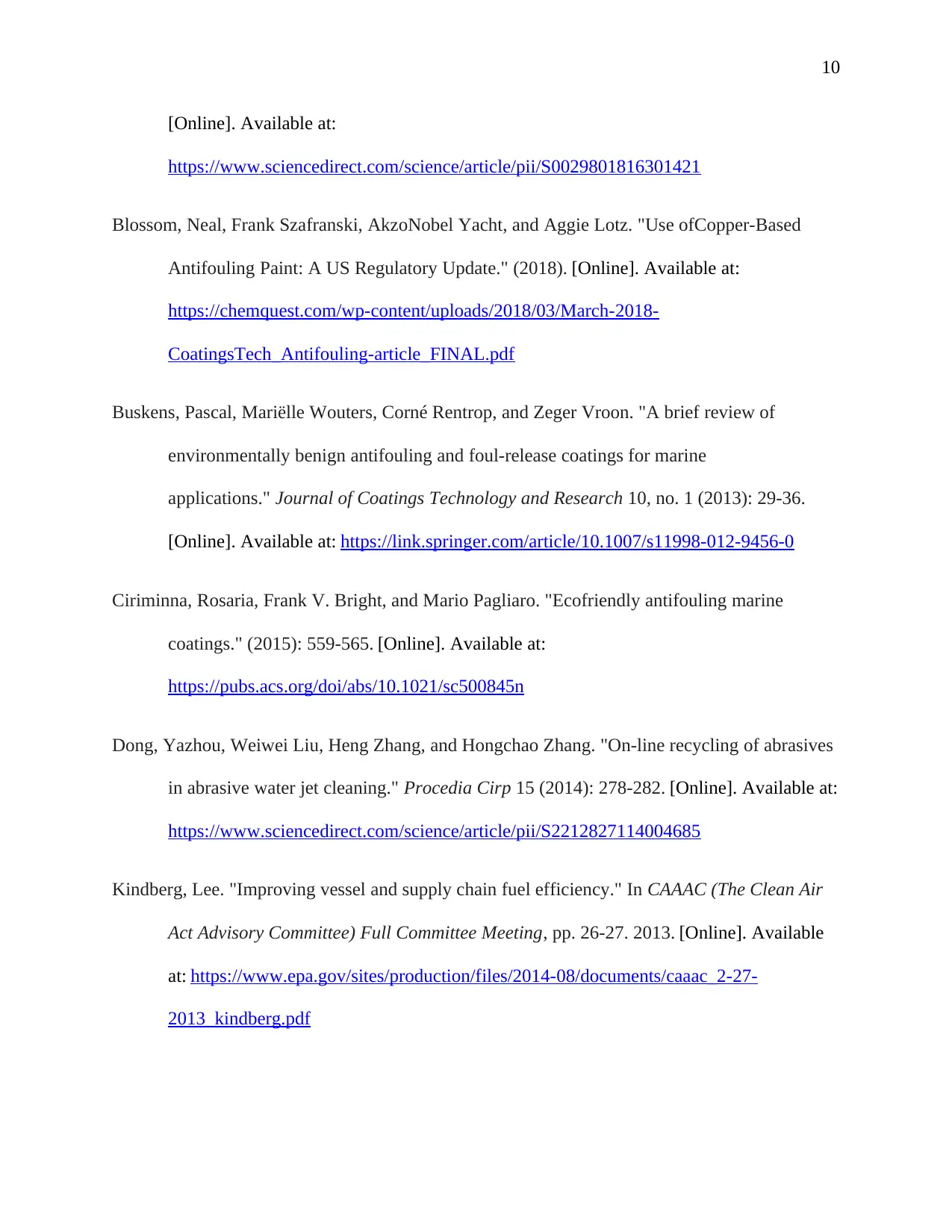
10
[Online]. Available at:
https://www.sciencedirect.com/science/article/pii/S0029801816301421
Blossom, Neal, Frank Szafranski, AkzoNobel Yacht, and Aggie Lotz. "Use ofCopper-Based
Antifouling Paint: A US Regulatory Update." (2018). [Online]. Available at:
https://chemquest.com/wp-content/uploads/2018/03/March-2018-
CoatingsTech_Antifouling-article_FINAL.pdf
Buskens, Pascal, Mariëlle Wouters, Corné Rentrop, and Zeger Vroon. "A brief review of
environmentally benign antifouling and foul-release coatings for marine
applications." Journal of Coatings Technology and Research 10, no. 1 (2013): 29-36.
[Online]. Available at: https://link.springer.com/article/10.1007/s11998-012-9456-0
Ciriminna, Rosaria, Frank V. Bright, and Mario Pagliaro. "Ecofriendly antifouling marine
coatings." (2015): 559-565. [Online]. Available at:
https://pubs.acs.org/doi/abs/10.1021/sc500845n
Dong, Yazhou, Weiwei Liu, Heng Zhang, and Hongchao Zhang. "On-line recycling of abrasives
in abrasive water jet cleaning." Procedia Cirp 15 (2014): 278-282. [Online]. Available at:
https://www.sciencedirect.com/science/article/pii/S2212827114004685
Kindberg, Lee. "Improving vessel and supply chain fuel efficiency." In CAAAC (The Clean Air
Act Advisory Committee) Full Committee Meeting, pp. 26-27. 2013. [Online]. Available
at: https://www.epa.gov/sites/production/files/2014-08/documents/caaac_2-27-
2013_kindberg.pdf
[Online]. Available at:
https://www.sciencedirect.com/science/article/pii/S0029801816301421
Blossom, Neal, Frank Szafranski, AkzoNobel Yacht, and Aggie Lotz. "Use ofCopper-Based
Antifouling Paint: A US Regulatory Update." (2018). [Online]. Available at:
https://chemquest.com/wp-content/uploads/2018/03/March-2018-
CoatingsTech_Antifouling-article_FINAL.pdf
Buskens, Pascal, Mariëlle Wouters, Corné Rentrop, and Zeger Vroon. "A brief review of
environmentally benign antifouling and foul-release coatings for marine
applications." Journal of Coatings Technology and Research 10, no. 1 (2013): 29-36.
[Online]. Available at: https://link.springer.com/article/10.1007/s11998-012-9456-0
Ciriminna, Rosaria, Frank V. Bright, and Mario Pagliaro. "Ecofriendly antifouling marine
coatings." (2015): 559-565. [Online]. Available at:
https://pubs.acs.org/doi/abs/10.1021/sc500845n
Dong, Yazhou, Weiwei Liu, Heng Zhang, and Hongchao Zhang. "On-line recycling of abrasives
in abrasive water jet cleaning." Procedia Cirp 15 (2014): 278-282. [Online]. Available at:
https://www.sciencedirect.com/science/article/pii/S2212827114004685
Kindberg, Lee. "Improving vessel and supply chain fuel efficiency." In CAAAC (The Clean Air
Act Advisory Committee) Full Committee Meeting, pp. 26-27. 2013. [Online]. Available
at: https://www.epa.gov/sites/production/files/2014-08/documents/caaac_2-27-
2013_kindberg.pdf
Paraphrase This Document
Need a fresh take? Get an instant paraphrase of this document with our AI Paraphraser
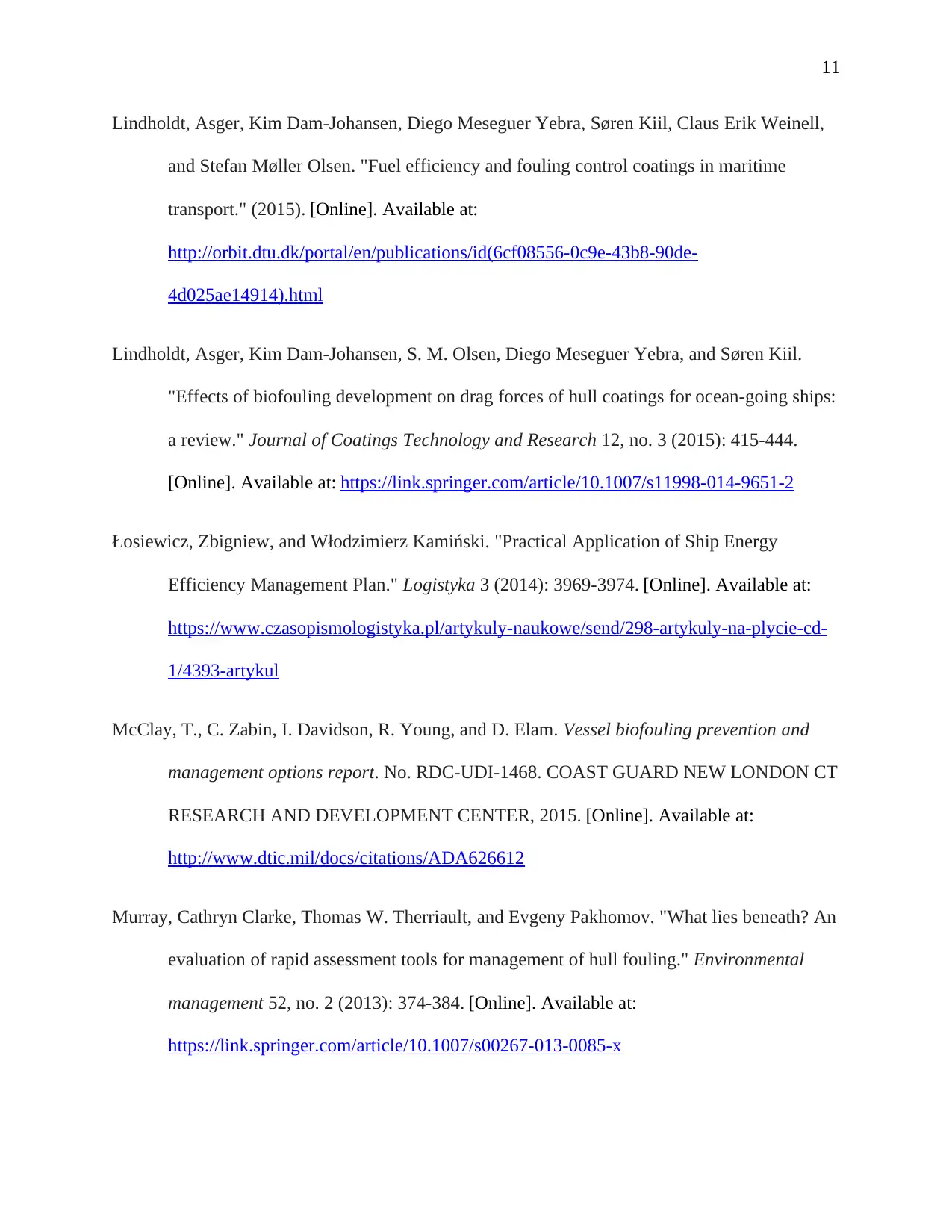
11
Lindholdt, Asger, Kim Dam-Johansen, Diego Meseguer Yebra, Søren Kiil, Claus Erik Weinell,
and Stefan Møller Olsen. "Fuel efficiency and fouling control coatings in maritime
transport." (2015). [Online]. Available at:
http://orbit.dtu.dk/portal/en/publications/id(6cf08556-0c9e-43b8-90de-
4d025ae14914).html
Lindholdt, Asger, Kim Dam-Johansen, S. M. Olsen, Diego Meseguer Yebra, and Søren Kiil.
"Effects of biofouling development on drag forces of hull coatings for ocean-going ships:
a review." Journal of Coatings Technology and Research 12, no. 3 (2015): 415-444.
[Online]. Available at: https://link.springer.com/article/10.1007/s11998-014-9651-2
Łosiewicz, Zbigniew, and Włodzimierz Kamiński. "Practical Application of Ship Energy
Efficiency Management Plan." Logistyka 3 (2014): 3969-3974. [Online]. Available at:
https://www.czasopismologistyka.pl/artykuly-naukowe/send/298-artykuly-na-plycie-cd-
1/4393-artykul
McClay, T., C. Zabin, I. Davidson, R. Young, and D. Elam. Vessel biofouling prevention and
management options report. No. RDC-UDI-1468. COAST GUARD NEW LONDON CT
RESEARCH AND DEVELOPMENT CENTER, 2015. [Online]. Available at:
http://www.dtic.mil/docs/citations/ADA626612
Murray, Cathryn Clarke, Thomas W. Therriault, and Evgeny Pakhomov. "What lies beneath? An
evaluation of rapid assessment tools for management of hull fouling." Environmental
management 52, no. 2 (2013): 374-384. [Online]. Available at:
https://link.springer.com/article/10.1007/s00267-013-0085-x
Lindholdt, Asger, Kim Dam-Johansen, Diego Meseguer Yebra, Søren Kiil, Claus Erik Weinell,
and Stefan Møller Olsen. "Fuel efficiency and fouling control coatings in maritime
transport." (2015). [Online]. Available at:
http://orbit.dtu.dk/portal/en/publications/id(6cf08556-0c9e-43b8-90de-
4d025ae14914).html
Lindholdt, Asger, Kim Dam-Johansen, S. M. Olsen, Diego Meseguer Yebra, and Søren Kiil.
"Effects of biofouling development on drag forces of hull coatings for ocean-going ships:
a review." Journal of Coatings Technology and Research 12, no. 3 (2015): 415-444.
[Online]. Available at: https://link.springer.com/article/10.1007/s11998-014-9651-2
Łosiewicz, Zbigniew, and Włodzimierz Kamiński. "Practical Application of Ship Energy
Efficiency Management Plan." Logistyka 3 (2014): 3969-3974. [Online]. Available at:
https://www.czasopismologistyka.pl/artykuly-naukowe/send/298-artykuly-na-plycie-cd-
1/4393-artykul
McClay, T., C. Zabin, I. Davidson, R. Young, and D. Elam. Vessel biofouling prevention and
management options report. No. RDC-UDI-1468. COAST GUARD NEW LONDON CT
RESEARCH AND DEVELOPMENT CENTER, 2015. [Online]. Available at:
http://www.dtic.mil/docs/citations/ADA626612
Murray, Cathryn Clarke, Thomas W. Therriault, and Evgeny Pakhomov. "What lies beneath? An
evaluation of rapid assessment tools for management of hull fouling." Environmental
management 52, no. 2 (2013): 374-384. [Online]. Available at:
https://link.springer.com/article/10.1007/s00267-013-0085-x

12
⊘ This is a preview!⊘
Do you want full access?
Subscribe today to unlock all pages.

Trusted by 1+ million students worldwide
1 out of 12
Your All-in-One AI-Powered Toolkit for Academic Success.
+13062052269
info@desklib.com
Available 24*7 on WhatsApp / Email
![[object Object]](/_next/static/media/star-bottom.7253800d.svg)
Unlock your academic potential
Copyright © 2020–2025 A2Z Services. All Rights Reserved. Developed and managed by ZUCOL.